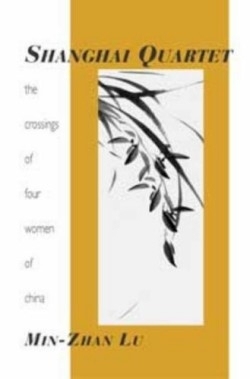Shanghai Quartet
The Crossings of Four Women of China
In her prologue, the author addresses her daughter: “I
turned to writing because I had not liked the way I talked about the flow between my past and present… I had hoped that writing… might help me break my anxiety over getting the story right and right away.“ It didn’t. Rather, that anxiety forced her to find a new form to contain the complexities of her story and of the relationships within it as they connect across time and space. Because this is a tale of yi min—immigrants, or people (min) who have moved (yi), of the places they moved from and the places they moved to, and of the times in which the moving took place—it takes place simultaneously on different dates and in different places.
As the author explains, yi can also mean the effort to change, shift, transplant, influence, transfer, or give. And it can mean fusion, confusion, or diffusion. The complex set of negotiations suggested by this word exceeds the limits of a simple linear structure. The anxiety to get it right and right away produces a text—with its fractured chronology, multiple voices, and shifting realities—that tells both a history of China in the twentieth century and a story about four women that is achingly (sometimes uncomfortably) personal.
The book offers a nuanced understanding of the achievements of women, naming the small personal success under difficult circumstances alongside the major cultural change. When the author’s grandmother, the Exceptional Haopo, gets what she always wanted—an education and a career as a teacher—it is at the cost of behaving strictly within the limits of the obedient, subservient daughter and/or wife, which, for her, appears to be no cost at all. It may be hard for readers to understand this, but is it philosophically any different from western women, who take for granted their rights of access to education and career, but remain in large numbers trapped within a damaging beauty myth? Is an eight-year-old with anorexia any less a victim of her society than Haopo with her bound and crippled feet?
In the fourth quartet—the story of Min-Zhan Lu herself, much of which happens in America and away from the other women—most of the background noise is turned off. The multiple voices that enriched the earlier sections are present now only as memories, and the book shifts to a more familiar linear structure, as befits the American life to which she has adjusted. The effect, however, is of listening to a piece of music as the sound changes from surround-sound to mono. The unexpected flatness stresses one of the book’s major points: tremendous losses are incurred in the march towards a better life.
Reviewed by
Jeannette Boyne
Disclosure: This article is not an endorsement, but a review. The publisher of this book provided free copies of the book to have their book reviewed by a professional reviewer. No fee was paid by the publisher for this review. Foreword Reviews only recommends books that we love. Foreword Magazine, Inc. is disclosing this in accordance with the Federal Trade Commission’s 16 CFR, Part 255.

